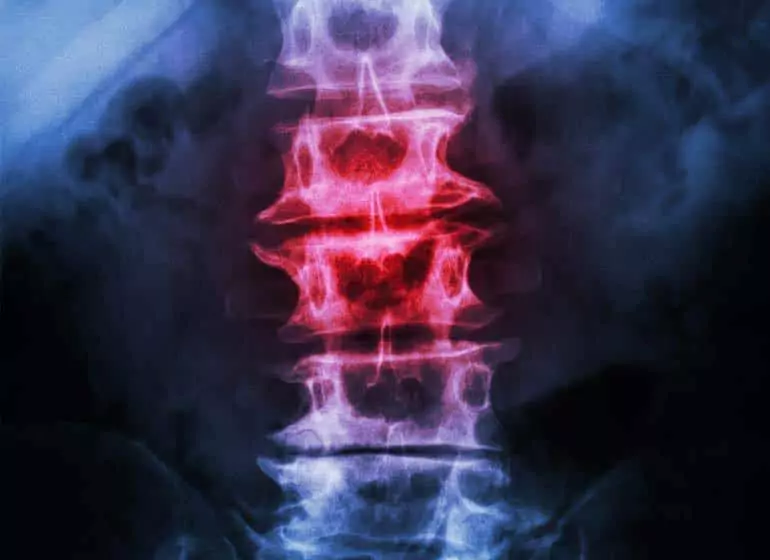

Chiropractic Care for Spondylosis in Anchorage, AK
Better Health Alaska: Expertly Treating Spondylosis
Ever since opening our doors in 1998, Better Health Alaska, headed by our CEO and chief chiropractor, Dr. Brent Wells, has been providing natural, holistic care to the residents of Anchorage and the surrounding areas. In that time, we’ve seen and treated innumerable musculoskeletal conditions including thousands of cases of spondylosis.
Spondylosis is a medical term that refers to a general degradation of the vertebrae of the spinal column due to any cause, but most often due to age and time. More specifically, it refers to the emergence of osteoarthritis in the spinal column due to the drying out of the discs within. As the discs dry out and thin, other signs may emerge as well, like:
- Development of bone spurs
- Thickening of ligaments
- Fracturing of the spinal bones
- The narrowing of the opening that let nerves exit the spine
Spondylosis should not be confused with spondylolisthesis which is a condition where one of the vertebrae in the spine (usually in the lower back) slips out of alignment with the vertebra below it. This often goes unnoticed, but in some cases can be a source of severe pain.

Better Health Alaska: What to Expect from Your Anchorage Chiropractor
Although spondylosis and spondylolisthesis differ, chiropractic care provides an effective, non-invasive, science-based way to treat both. For our purposes here, we will focus on spondylosis.
Your First Visit
Your first visit to the Better Health office will begin with a frank discussion of your symptoms with an Anchorage-based chiropractor. He/she will also go over your medical history – both personal and family. From there, you’ll receive a thorough exam which may or may not involve imaging (MRI, x-ray, what-have-you).
Next, the chiropractor will render an official diagnosis. With the diagnosis in hand, and the accumulated information previously gathered, the chiropractor will develop a comprehensive treatment plan tailored to your specific needs.
Benefits of Regular Chiropractic Treatment in Anchorage for Spondylosis
Typical treatment plans will entail visiting the office for on-site treatments over the course of several weeks. In most cases of spondylosis, treatment consists of physical therapy and other exercises that strengthen the muscles that surround the area of concern. This helps relieve excess strain there.
Some cases – like those that involve spondylolisthesis as well – may require a chiropractic back adjustment. Over-the-counter anti-inflammatory medications are also used at times. Fortunately, most people respond well to such conservative, non-invasive therapies. In the rare instances where they don’t or they need more specialized help, our chiropractors can refer them to a surgeon or other specialist of the appropriate field.
All told, Better Health Alaska – whether it’s for spondylosis, spondylolisthesis, or something else – is the place to go for the same day chiropractic adjustment near you. Reach out, and we’ll get you in.
Visit Better Health Alaska
South Anchorage
- 8840 Old Seward Hwy E, Anchorage, Alaska 99515
- Phone: 907-743-0110
- Open Hours: 9AM to 7PM
Spondylolisthesis Chiropractic Care: Does it Work?

Spondylolisthesis chiropractic care in Anchorage or Juneau: If you’re suffering from symptoms of spondylolisthesis, chiropractic care may be able to help reduce pain and improve range of motion, getting you back to your daily life and activities.
Chiropractic care is an effective way to treat the symptoms of spondylolisthesis. It’s the symptoms that often disrupt people’s lives, and the right chiropractic approach can provide relief. Spondylolisthesis chiropractic care takes many forms, depending on the severity and the patient’s symptoms.
Can a Chiropractor Fix Spondylolisthesis?
Spondylolisthesis is a term to describe when one of the vertebra (usually in the lower back) slips out of line with the vertebra below it. And while this is relatively common, it often doesn’t cause any negative symptoms. However, when it does, it can cause pain in the back and down one or both of the legs.
This is not to be confused with spondylosis, which is a narrowing of the space between vertebrae due to age-related arthritis. These are two different issues, but they often present at the same time. Often, spondylosis can lead to spondylolisthesis if allowed to progress. Luckily there are natural remedies for cervical spondylosis and spondylolisthesis.
But, before we talk about the different types of treatments, let’s take a look at some evidence that chiropractic care can help spondylolisthesis.
Spondylolisthesis Chiropractic Case Studies
Most cases of spondylolisthesis can be effectively treated with conservative methods, including chiropractic care. Some rare and severe cases may require surgery.
But since medical care should be based on evidence, it’s important that you have an idea of how effective chiropractic care is for spondylolisthesis.
Flexion-Distraction Manipulation for Spondylolisthesis
This case study details the treatment of a 40-year-old man suffering from pain and tingling in the low back and down the left leg. He described the pain at the beginning of treatment as a 9 out of 10. Imaging showed that he had spondylolytic spondylolisthesis and disc protrusion.
The chiropractic doctor treated the patient with only Cox flexion-distraction manipulation, which is a common form of manipulation used to relieve spinal pain through decompression. The patient had 9 sessions over 4 weeks. At the end of the treatment, he reported pain at a 0 out of 10.
During follow-up 10 years later, there was no sign of the initial symptoms, showing that the treatment had worked well without negative side effects, as to be expected.
Treatment of a Marine Corps Veteran with Spondylolisthesis
Another case study details the treatment of a Marine Corps veteran who had been suffering from mechanical back pain for 20 years at the time of treatment. An injury sustained during active duty had caused his back pain. He had radiating numbness and tingling in his right leg.
Upon diagnosis, the chiropractic doctor determined that the man had spondylolisthesis in two different places in the spine. The veteran underwent 10 total treatment sessions over an 8-week period. The treatment consisted of flexion-distraction techniques and activity modification.
At the end of the 8 weeks, the patient reported a 25% reduction in low back pain. He also had a 22% reduction in perceived disability associated with low back pain. This much progress in such a short period is promising, especially since he had been having issues for 20 years.
High-Grade Spondylolisthesis Treated Successfully

This third case study is all about a 28-year-old woman suffering from high-grade spondylolisthesis with pain at a 6 out of 10. She had been suffering from intermittent pain for about 10 years when she sought treatment. She had spoken to surgeons who told her she wouldn’t be able to have children and would end up in a wheelchair without surgery.
She underwent conservative chiropractic care. Her treatment included spinal manipulation, Active Release Techniques, and trigger point therapy. She was also given home-based stretching and exercises that were designed to help mobilize her spine naturally by strengthening her core.
She had 9 sessions over 5 weeks, which resulted in reducing her pain level to a 2 out of 10 and allowing her to become functional once again. The authors of the study held that the woman would be able to have children without any issues with her spondylolisthesis. She was advised to continue chiropractic care as needed in the future.
Chiropractic Care Can Lower Instances of Opioid Use
We’ve included this study because it is painfully clear to many in the medical community how dangerous opioid use can be. And one of the major reasons physicians prescribes opioids is chronic low back pain.
But several studies have shown that those who seek chiropractic care are less likely to use opioids both in the short term and the long term. One analysis found that those who sought chiropractic care for their back or neck pain had a 64% lower chance of filling an opioid prescription.
This is to say nothing about the true effect that opioids have on the cause of the pain, which is little to none. They help mask the pain, but they do nothing to actually stop the pain from recurring. Of course, painkillers have their place, but there’s a better, safer way to do things for most. And that way is chiropractic care.
Chiropractic Care for Spondylolisthesis
Now that we’ve covered some important case studies, you should have a decent idea of what chiropractors do for spondylolisthesis. But treatment varies depending on the needs of the given patient and the level of severity of the vertebral slip.
A common chiropractic process for determining the treatment of spondylolisthesis will look something like this:
- All chiropractic visits will start with a medical history, just as visiting any other doctor would. This will include both a family and personal history.
- The chiropractor will perform a thorough examination, which may or may not include an x-ray, CT scan, or other imaging.
- The chiropractor will determine the extent of the immobilization and will often perform an examination by touch, feeling for joint movement, tightness, and other abnormalities.
- The patient will undergo a posture and gait analysis, which will help the chiropractor determine how the person moves and how spondylolisthesis may be affecting body mechanics.
- Next, the chiropractor will determine the stability of the spondylolisthesis. Sometimes, this may require an MRI.
Once the doctor of chiropractic has all this information, he or she can then put together a treatment plan with the patient. Often, treatment involves:
- Flexion-distraction manipulation.
- Instrument-assisted manipulation.
- Spinal manipulation of specific joints.
- Soft tissue therapy.
- Trigger point therapy.
- Physical therapy exercises.
- Massage therapy.
- Home exercises.
It’s important to note that chiropractors do not prescribe medicine. Rather, they prefer to do things naturally and holistically. In fact, as mentioned above, chiropractic care has been shown to reduce the need for dangerous and addictive pain pills.
However, in some extreme cases, an Anchorage chiropractor may refer a patient in extreme pain to a surgeon or work with doctors who may suggest painkillers or other treatment options. A chiropractor’s ultimate goal is to provide relief and to return the patient to a healthy state. And that means doing what’s best for the patient.
Steroids for Spondylolisthesis
Other than conservative care, steroid injections are often used to treat spondylolisthesis before surgery is considered. However, there is little evidence to suggest that these injections have any long-term beneficial effects. They may provide short-term relief from pain, but without other conservative treatments, such as chiropractic care, this will be of little use to the patient.
One study on the efficacy of steroid injections found that, among those who didn’t have surgery, the injections provided inferior pain relief over the course of three years. The same study also found that steroid injections didn’t have any effect on surgery rates, either positive or negative.
Unfortunately, steroid injections are often a band-aid for those with spondylolisthesis. On the other hand, chiropractic care is a safe, effective, and conservative course of treatment that can help prevent the need for surgery.
Spondylolisthesis Chiropractic: Conclusion
At Better Health Chiropractic and Physical Rehab, we’re no stranger to spondylolisthesis. We base our treatments on evidence, case studies, and our 20+ years of experience as a top-rated chiropractor in Alaska. We offer a wide range of treatment options, including our proprietary Alaska Back Pain Protocol, which includes spinal manipulation, spinal decompression, massage, and physical rehab. It’s all non-invasive and safe.
For those rare few with high-grade spondylolisthesis, we also work with specialists in other medical fields to get our patients the care that they need to live full, pain-free lives.
We’ve helped thousands of Alaskans overcome their back pain over the years, and we hope to do the same for you!
Contact our Anchorage clinic for chiropractic today to learn more or to make an appointment.
Conditions Helped by Chiropractors:
Same-Day Chiropractic Appointment. 10-Minute Wait Promise.
Better Health Alaska Chiropractors has helped thousands of patients get their life back through safe, effective, and cutting-edge treatments like the Alaska Back Pain Protocol. We use a multi-pronged, non-invasive approach to treat different conditions. And it’s done at a reasonable cost. We accept many types of insurance, and most insured patients pay $25 or less per visit. We even have options for the uninsured.


